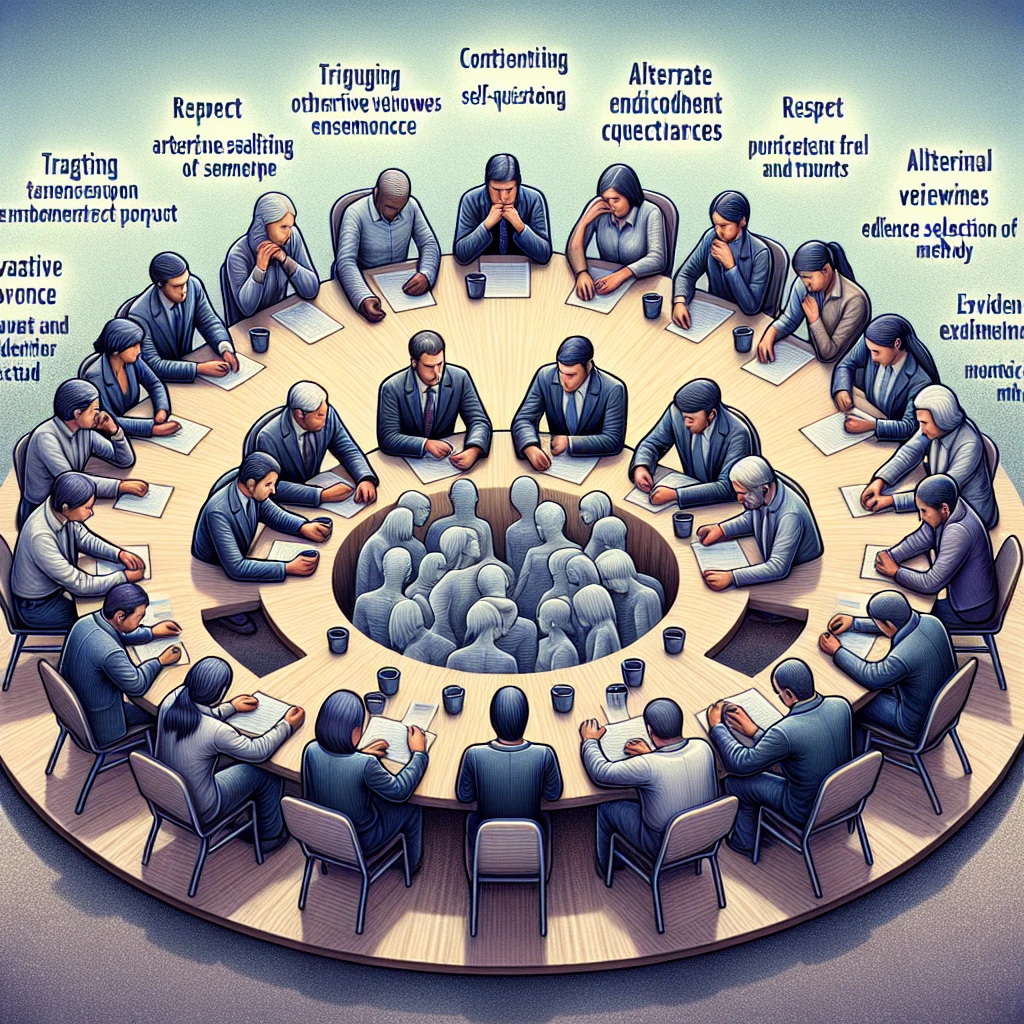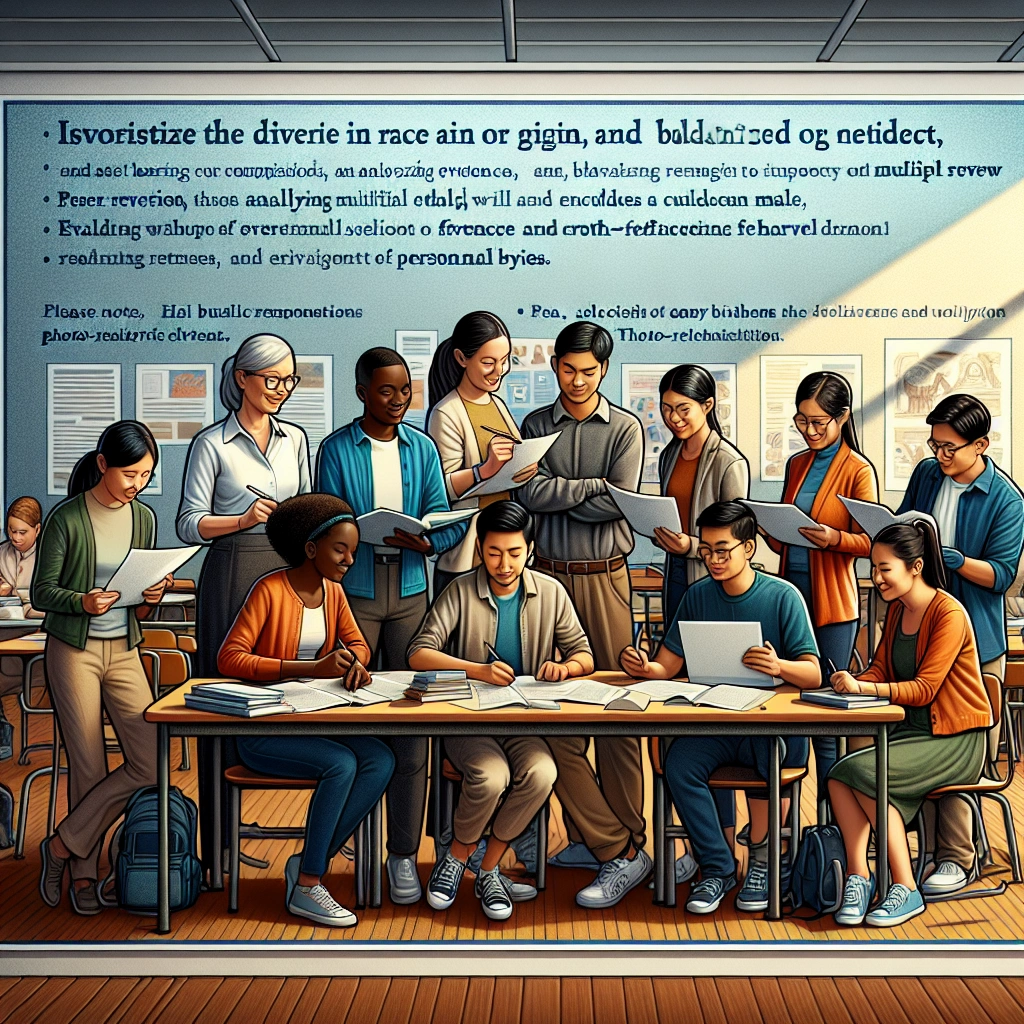What Techniques Can Be Used To Avoid Biases In Evidence Selection Is Important – Guide


Bias in evidence selection refers to the systematic error introduced into research by selecting one outcome over others. It is important to avoid biases in evidence selection to ensure the validity and reliability of research findings.
Selection bias can impact the accuracy of study results and lead to incorrect conclusions, making it crucial to use techniques to minimize and avoid biases in evidence selection.
Check out this Youtube video: If you want to learn about techniques to avoid biases in evidence selection, “How to avoid bias in scientific tests” is a must-watch!
Understanding Bias in Evidence Selection
Bias in evidence selection refers to the systematic errors that can occur when collecting, analyzing, and interpreting data. These biases can significantly impact the validity and reliability of research findings and ultimately influence decision-making processes.
Understanding the various types of biases is crucial for ensuring the integrity of evidence-based practices and informed decision-making.
Types of Biases in Evidence Selection
- Selection Bias: This occurs when there are discrepancies in the selection of participants, leading to a non-representative sample that may skew research outcomes.
- Performance Bias: Arises from differences in the care provided to research participants, impacting the evaluation of outcomes.
- Detection Bias: Results from systematic differences in outcome assessment methods, potentially leading to inaccurate conclusions.
- Attrition Bias: Occurs when there are differential rates of loss to follow-up or incomplete data, influencing the analysis and interpretation of results.
- Reporting Bias: Involves selective reporting of results, often omitting unfavorable outcomes, which can distort the overall picture.
- Publication Bias: Arises from the selective publication of studies based on the direction and significance of results, leading to an incomplete representation of evidence.
Examples of Biased Evidence Selection
An example of selection bias is evident in healthcare studies where certain demographics may be overrepresented, leading to findings that do not accurately reflect the broader population. In clinical trials, performance bias can occur if healthcare providers give differential care to participants, impacting the assessment of treatment effectiveness.
Another example is publication bias, where studies with positive outcomes are more likely to be published, potentially skewing the overall evidence base.
The Impact of Biases in Evidence Selection
Selection bias in evidence selection can have significant consequences, leading to inflated effect sizes or inaccurate findings. It occurs when the intervention or test is studied in a non-representative sample population, undermining the reliability of the results.
Consequences of Biased Evidence Selection
The consequences of biased evidence selection are far-reaching. It can distort the overall effect sizes, leading to misguided conclusions and impacting the validity of research outcomes.
This bias can result in misinformed decision-making, affecting not just the study participants but potentially entire communities.
Case Studies Highlighting the Impact of Biased Evidence
Case studies vividly illustrate the real-world implications of biased evidence selection. For instance, in healthcare, channeling bias in observational studies can lead to varying cohort assignments based on patient characteristics, impacting treatment outcomes.
Additionally, research in the health professions can suffer from unrecognized bias, undermining the utility of study results and evidence-based decision-making.
Recognizing Biases in Evidence Selection
Identifying Red Flags in Evidence
To identify red flags in evidence, it’s crucial to look for any indications of bias, cherry-picked data, or skewed interpretations that may sway the outcome. For instance, if a study selectively highlights only positive results while minimizing or ignoring negative findings, it raises a red flag of potential bias.
Another red flag could be the absence of diverse perspectives or research sources, indicating a lack of comprehensive analysis.
Critical Evaluation of Sources
When critically evaluating sources, it’s essential to assess their purpose, authority, credibility, accuracy, and currency. For example, scrutinizing the credentials and affiliations of the authors can provide insights into potential biases or vested interests.
Additionally, cross-referencing information with other reputable sources can help validate the reliability and relevance of the evidence. Employing lateral reading, which involves comparing the source with others to verify evidence and contextualize information, adds another layer of critical evaluation.
Techniques for Avoiding Biases in Evidence Selection
Utilizing Multiple Sources
- Utilizing multiple sources is essential in avoiding biases in evidence selection as it helps to gather a comprehensive range of information, reducing the risk of relying on biased or skewed data from a single source.
Cross-Referencing Information
- Cross-referencing information is crucial as it allows for the validation of data across various sources, ensuring that the evidence is consistent and reliable. This process helps in identifying any discrepancies or biases present in the information.
Seeking Diverse Perspectives
- Seeking diverse perspectives is important to avoid biases as it provides a well-rounded understanding of the subject matter, allowing for the consideration of various viewpoints and minimizing the impact of any singular bias or preconceived notions.
Applying Critical Thinking
- Applying critical thinking is a key technique to avoid biases in evidence selection, enabling individuals to assess and analyze information objectively, identifying any potential biases or gaps in the evidence and making informed decisions based on facts and logic.
Implementing Unbiased Evidence Selection in Research
Best Practices for Researchers
Conducting a comprehensive search across multiple databases and sources is essential to avoid biases in evidence selection. Researchers should employ a variety of search terms and techniques to ensure a thorough and diverse review of existing literature.
Additionally, utilizing a dual review process, wherein two independent researchers analyze and interpret the criteria, can significantly reduce potential bias and enhance the consistency of evidence selection criteria interpretation.
Tools and Resources for Unbiased Evidence Selection
Researchers can benefit from utilizing scholarly databases such as LexisNexis and EBSCO for accessing credible and reliable sources. These databases provide a wide array of information that can be trusted for academic and research purposes.
Additionally, academic journals and books are highly valuable resources for finding trustworthy and evidence-backed content, enabling researchers to make informed and unbiased evidence selections.
Overcoming Personal Biases in Evidence Selection
Recognizing Personal Biases
It’s essential to acknowledge our own biases, whether conscious or unconscious. But it’s not enough to just recognize them; education and self-awareness are the key factors.
By actively seeking to understand our biases and their impact, we can work towards minimizing their effects.
Strategies for Overcoming Biases in Evidence Selection
Introspection plays a crucial role in identifying and addressing biases. Taking implicit association tests and practicing mindfulness can help in reducing bias.
Another effective strategy is perspective-taking, where we consider experiences from the point of view of the person being stereotyped. Additionally, learning to slow down and reflect before interacting with certain groups can significantly reduce reflexive actions influenced by biases.
| Common Stragegies | Effectiveness |
|---|---|
| Introspection | High |
| Mindfulness | Moderate |
| Perspective-taking | High |
| Slowing Down and Reflecting | Moderate |
These practices, when consciously implemented, can lead to a more unbiased approach in evidence selection, ensuring fair and accurate decision-making.
Challenges in Avoiding Biases in Evidence Selection
Unbiased evidence selection presents several challenges. One common hurdle is selection bias, which occurs when the study population is not clearly defined, leading to inconsistencies and risk of bias.
Another hurdle is the sheer volume of research evidence, making it difficult to apply global evidence in a local clinical setting. Additionally, evaluating biases, whether positive or negative, can be challenging, especially when unconscious bias is involved.
Common Hurdles in Unbiased Evidence Selection
- Selection Bias: Occurs when the study population is not clearly defined, resulting in inconsistencies and bias risk.
- Volume of Research Evidence: The sheer volume makes it challenging to apply global evidence in a local clinical setting.
- Unconscious Bias: Evaluating unconscious bias, whether positive or negative, can be particularly challenging.
Strategies for Overcoming Challenges
To overcome these challenges, clear definition and reliable identification of the study population are crucial. Implementing dual review practices and reporting the steps taken to avoid bias in selecting studies can help reduce potential biases.
Intentional strategies, drugs, and effective interventions are also being explored to overcome biases in research. Moreover, it is vital to critically review bias in each phase of research – planning, data collection, analysis, and publication.
Enhancing Critical Thinking Skills
Critical thinking skills can be enhanced by encouraging students to ask questions, actively participate in discussions, and engage in active learning. By practicing with real-life examples and going beyond academic learning, students can develop a deeper understanding of complex issues and learn to think critically.
Additionally, utilizing Bloom’s Taxonomy as a framework can help in defining and distinguishing different levels of human cognition, thus enhancing the critical thinking process. This strategic approach empowers students to reason, learn, and comprehend information effectively, fostering a more analytical mindset.
Developing Analytical Skills
Improving analytical skills involves various strategies such as downloading apps for mental exercises, keeping a journal to track thought processes, asking probing questions to dissect information, and joining debate forums to train the mind in critical analysis. Engaging with data and practicing analytical skills regularly can significantly improve students’ ability to interpret complex problems and form more sophisticated ideas, leading to heightened analytical proficiency.
Improving Information Literacy
To strengthen information literacy skills, students should be encouraged to extend their learning beyond content knowledge by making recommendations, comparing divergent ideas, and synthesizing information from multiple sources. Furthermore, developing the ability to recognize quality sources and critically assess information plays a vital role in enhancing information literacy skills.
This enables individuals to effectively identify, analyze, and communicate information in various formats, empowering them to make well-informed decisions based on credible and reliable sources.
The Role of Ethics in Evidence Selection
The role of ethics in evidence selection is paramount, ensuring that research upholds the highest standards of integrity and fairness. Ethical considerations in research encompass principles such as voluntary participation, informed consent, anonymity, confidentiality, potential for harm, and results communication, safeguarding the rights and well-being of research participants.
Ethical Considerations in Research
In research, ethical considerations serve as fundamental guidelines to ensure that the rights, safety, and well-being of research participants are protected. Research designs and practices must adhere to a certain code of conduct.
Key ethical considerations include obtaining informed consent from study participants, ensuring fair subject selection, assessing the risk-benefit ratio, and seeking independent review to maintain scientific validity.
Ethical Guidelines for Evidence Selection
Ethical guidelines are imperative in clinical research to protect patient welfare and maintain the credibility of research. The principles of beneficence, nonmaleficence, autonomy, and justice guide ethical guidelines, emphasizing the importance of informed consent, truth-telling, and confidentiality.
Adhering to these ethics principles promotes the aims of research, such as knowledge, truth, and avoidance of error, upholding integrity and credibility in evidence selection.
Building Trust through Unbiased Evidence Selection
In order to enhance credibility and improve the trustworthiness of research findings, there are several key techniques that can be utilized. One effective approach is the implementation of systematic reviews and meta-analyses, which involve rigorous methods to identify and assimilate all relevant studies.
This ensures that the best scientific evidence is incorporated while minimizing the risk of bias in evidence selection.
Another crucial technique is being transparent about preferences and perspectives throughout the research process. This not only increases the credibility of the findings but also makes the research process more trustworthy from the outset.
It’s essential to demonstrate congruence with reality and link the research study’s findings with truth to establish credibility.
Moreover, leveraging strategies such as triangulation, member checking, peer review, reflexivity, and audit trails can significantly enhance the trustworthiness of qualitative research. These tactics strengthen the validity of the findings and mitigate potential biases in evidence selection, fostering greater confidence in the research outcomes.
Furthermore, prolonged engagement, saturation, rapport building, iterative questioning, and member involvement are crucial approaches to bolster credibility in qualitative research. These strategies contribute to the robustness of the findings, thereby elevating the overall trustworthiness of the research outcomes.
Addressing Counterarguments against Unbiased Evidence Selection
Common Misconceptions about Bias in Evidence Selection
One common misconception about bias in evidence selection is that retrospective studies are more biased than other types, while randomized controlled trials are not biased due to randomization. This overlooks the potential biases present in the selection of participants and the interpretation of results.
Another misconception is the belief that some research is completely free from bias, ignoring the inherent limitations and potential sources of bias in any study.
Debunking Myths about Unbiased Evidence Selection
To address these misconceptions, it’s essential to acknowledge that bias results from systematic deviation from the truth. No research is entirely free from bias, and it’s crucial to recognize and mitigate potential biases in evidence selection.
Whether it’s the selection of subjects into a study or the interpretation of results, biases can significantly impact the validity of research findings. Highlighting the presence of bias and taking active steps to minimize its impact is crucial in ensuring the integrity of evidence selection.
Collaborative Efforts for Unbiased Evidence Selection
Collaborative efforts for unbiased evidence selection are crucial to promoting transparency in research. By integrating multiple bodies of evidence through strong methodological approaches in systematic reviews, we can ensure the transparency, consistency, and scientific rigor of research reports.
Encouraging collaboration in evidence selection involves addressing the cycle of bias in health research, which includes methodological flaws threatening a study’s internal and external validity. This collaboration can mitigate the impact of conflict of interest (COI)-related biases and enhance the ability of studies to provide accurate answers.
Additionally, promoting transparency in research involves actions such as identifying and avoiding bias in research, as well as adopting open practices like registering studies, sharing study data, and publicly reporting research findings. This practice is essential for improving research integrity and building trust in scientific findings.
Furthermore, transparency in research and reporting fosters the responsibility for promoting greater openness in research, making it a collective effort from researchers, institutions, and communities.
In a nutshell, collaborative efforts for unbiased evidence selection require integrating bodies of evidence, addressing the cycle of bias in health research, and promoting research transparency through responsible and open practices.
Educational Initiatives for Unbiased Evidence Selection
Integrating Unbiased Evidence Selection into Educational Curriculum
Lora Turner’s approach to integrating unbiased evidence selection into educational curriculum involves incorporating case studies that highlight the impact of biased evidence on decision-making. By analyzing real-world scenarios, students can understand the consequences of biased evidence and learn to critically evaluate information.
Additionally, interactive activities such as role-playing exercises can provide students with firsthand experience in identifying and avoiding biased evidence, fostering a deeper understanding of the importance of unbiased evidence selection.
Training Programs for Researchers and Students
Turner emphasizes the implementation of comprehensive training programs for researchers and students, focusing on practical techniques to identify and mitigate biases in evidence selection. By organizing workshops and seminars led by industry experts, participants can develop essential skills in evidence evaluation, ensuring the cultivation of a discerning approach towards evidence selection.
Furthermore, the introduction of mentorship programs can provide ongoing guidance, allowing individuals to apply unbiased evidence selection methods effectively in their research and academic pursuits.
Ensuring Fairness and Objectivity in Evidence Selection
Ensuring fairness and objectivity in evidence selection is crucial for promoting fair and just practices and fostering objectivity in decision-making. It involves implementing techniques to avoid biases, ensuring a transparent and unbiased selection process, thus enhancing the overall effectiveness of decision-making.
Promoting Fair and Just Practices
Promoting fair and just practices requires the implementation of blind recruitment processes where candidate information such as name, gender, and ethnicity is hidden to reduce unconscious biases. Additionally, using structured interview techniques and standardized assessment criteria can ensure fairness in the evaluation process, ultimately promoting equal opportunities for all candidates.
Fostering Objectivity in Decision-Making
Fostering objectivity in decision-making involves the use of decision matrices to weigh various factors and options objectively. Moreover, breaking decisions into smaller parts and mitigating bias with the right set of inputs can enhance the objectivity of the decision-making process, leading to more well-informed and unbiased outcomes.
| Techniques for Fairness and Objectivity | Description |
|---|---|
| Blind Recruitment Process | Hides candidate information to reduce unconscious biases. |
| Structured Interview Techniques | Ensures fairness in the evaluation process by using standardized assessment criteria. |
| Decision Matrices | Weighs various factors objectively to foster unbiased decision-making. |
Ensuring fairness and objectivity in evidence selection is crucial for promoting fair and just practices and fostering objectivity in decision-making. Implementation of these techniques can lead to a more equitable and unbiased process, ultimately resulting in better outcomes.
The Future of Unbiased Evidence Selection
Artificial intelligence, wearable technologies, and data science are revolutionizing evidence-based medicine. With the integration of machine learning, healthcare professionals now have access to advanced tools for unbiased evidence selection, enabling the identification of significant trends and critical gaps in current research.
This technological advancement enhances the accuracy and depth of evidence collection, contributing to more comprehensive and impartial conclusions.
Advancements in Technology for Unbiased Evidence Selection
The systematic literature review process, empowered by technological advancements, facilitates the unbiased collection and assessment of a vast body of literature to achieve impartial conclusions. Wearable technologies and data science play a pivotal role in transforming evidence-based medicine, providing a tantalizing glimpse into the future of unbiased evidence selection.
The integration of AI-powered gadgets and data analytics offers unprecedented opportunities for refining evidence collection and improving research methodologies.
Trends in Research Methodology for Unbiased Evidence Selection
Scoping reviews have emerged as a common approach to evidence synthesis, characterized by methodological guidance for comprehensive evidence planning, conduct, and reporting. These reviews utilize advanced methodology frameworks, such as the JBI methodology and the Preferred Reporting Items for Systematic Reviews and Meta-Analyses-Extension for Scoping Reviews, contributing to reinforcing and advancing the methodology.
Additionally, the evolution of clinical trials and evidence generation has paved the way for standards that ensure comprehensive research, encompassing both published and unpublished studies to mitigate potential biases in evidence selection.
| Advancements in Technology | Trends in Research Methodology |
|---|---|
| Integration of machine learning in evidence-based medicine | Utilization of scoping reviews for comprehensive evidence synthesis |
| Use of wearable technologies for data collection | Embracing advanced methodology frameworks for evidence planning |
| AI-powered gadgets for refining evidence collection | Implementation of standards for comprehensive research |
The future of unbiased evidence selection lies in the seamless integration of technological advancements and evolving research methodologies, leading to more precise and impartial outcomes. As we propel into a new era of healthcare, leveraging these innovations will be crucial in ensuring the integrity and reliability of evidence-based practices.
Recommended Amazon Products for Techniques to Avoid Biases in Evidence Selection
Here’s a curated list of products that can help you avoid biases in evidence selection with ease. These recommendations are based on the functionality, price, and reviews of the products.
1. Tablet Stand
A tablet stand can be very useful for cross-referencing information from multiple sources, which is essential for avoiding biases in evidence selection. The adjustable tablet stand from Lamicall is highly recommended for its sturdy build and versatility. It allows you to view your tablet from different angles, making it easier to analyze and critically evaluate sources.
Adjustable Tablet Stand


| Pros | Cons |
|---|---|
| Versatile | Limited color options |
| Sturdy build | |
| Adjustable angles |
2. Noise-Cancelling Headphones
When seeking diverse perspectives and eliminating personal biases, noise-cancelling headphones can be a great tool. The Bose QuietComfort 35 II headphones are top-rated for their exceptional noise-cancellation technology and comfortable fit, allowing you to focus on analyzing evidence without distractions.
QuietComfort 35 II Headphones


| Pros | Cons |
|---|---|
| Superior noise-cancellation | Higher price point |
| Comfortable fit | |
| Wireless connectivity |
3. Research Journal
Keeping a research journal is essential for applying critical thinking and recognizing personal biases. The Moleskine Classic Notebook is a highly recommended journal known for its durable cover and premium quality paper, making it the ideal companion for unbiased evidence selection.
Moleskine Classic Notebook


| Pros | Cons |
|---|---|
| Durable cover | Slightly expensive |
| Premium paper | |
| Available in various sizes |
4. Desk Lamp with Adjustable Brightness
Enhancing critical thinking skills and fostering objectivity in decision-making can be supported by proper lighting conditions. The TaoTronics LED Desk Lamp offers adjustable brightness levels and color temperatures to create an optimal environment for analyzing evidence objectively.
TaoTronics LED Desk Lamp


| Pros | Cons |
|---|---|
| Adjustable brightness and color | Not dimmable |
| Multiple lighting modes | |
| USB charging port |
5. Research Methodology Book
For educational initiatives and continuous improvement of unbiased evidence selection skills, a comprehensive book on research methodology is highly recommended. “Research Methodology: A Step-by-Step Guide for Beginners” by Ranjit Kumar provides valuable insights and practical strategies for researchers and students.
Research Methodology: A Step-by-Step Guide for Beginners


| Pros | Cons |
|---|---|
| Comprehensive guide | Higher price |
| Practical strategies | |
| Beginner-friendly |
Top Recommended Product for Techniques to Avoid Biases in Evidence Selection
If you’re looking for the best solution for avoiding biases in evidence selection, we highly recommend the Bose QuietComfort 35 II Headphones. Here’s why:
The Bose QuietComfort 35 II headphones provide superior noise-cancellation technology, allowing you to focus on critically evaluating evidence without distractions. Their wireless connectivity and comfortable fit make them the top choice for fostering objectivity and enhancing critical thinking skills. Ready to improve your unbiased evidence selection? Check out the QuietComfort 35 II Headphones today for the best results!


Conclusion
The use of diverse sources for evidence selection is crucial in avoiding biases. By considering a wide range of perspectives and data, researchers can mitigate the influence of individual biases and ensure a more balanced and comprehensive analysis.
Additionally, implementing rigorous evaluation criteria and screening processes can help identify and eliminate any potential biases in evidence selection. This includes carefully assessing the quality, relevance, and reliability of the sources to uphold the credibility and objectivity of the research findings.
Furthermore, promoting transparency and disclosure of potential conflicts of interest can also contribute to avoiding biases in evidence selection. By openly acknowledging any affiliations or external influences, researchers can uphold the integrity and trustworthiness of their work, thereby enhancing the validity and reliability of their findings.


















